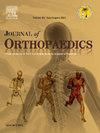Andrographolide suppresses fibrogenic phenotype of chondrocytes and ameliorates osteoarthritis by regulating miR-137/BMP7 axis
IF 1.5
Q3 ORTHOPEDICS
引用次数: 0
Abstract
Background
Pathogenic degeneration of cartilage and the generation of fibrotic cartilage are crucial characteristics linked to the progression of osteoarthritis (OA). The current research aims to explore the potential function of the miR-137/BMP7 pathway in regulating the fibrogenic transition of chondrocytes associated with OA, as well as assess the therapeutic potential of andrographolide.
Methods
Samples of cartilage from the knees of patients with OA and individuals without OA were gathered to investigate the expression patterns of miR-137, BMP7, and markers associated with fibrosis. A cell model using primary chondrocytes stimulated with interleukin (IL)-1β was developed to study the involvement of the miR-137/BMP7 axis during the fibrogenic transition of these cells. Additionally, we utilized an animal model of OA in order to assess the beneficial effects of the anti-inflammatory natural compound andrographolide on the fibrogenesis induced by OA in vivo.
Results
Elevated levels of fibrogenic and inflammatory factors were linked to decreased miR-137 expression in OA samples. In IL-1β-treated chondrocytes, there was an upregulation of fibrogenic markers alongside a reduction in miR-137 levels. The overexpression of miR-137 inhibited fibrogenesis through the negative regulation of BMP7. Additionally, treatment with andrographolide was effective in attenuating the fibrogenic phenotype in chondrocytes and mitigating OA pathogenesis via modulating the miR-137/BMP7 pathway.
Conclusion
miR-137 downregulation and BMP7 overexpression might contribute to the fibrogenic features in OA-related chondrocytes. Andrographolide attenuates fibrogenic phenotype in chondrocytes and alleviates the severity of OA by modulating the miR-137/BMP7 axis.
穿心莲内酯通过调节miR-137/BMP7轴抑制软骨细胞纤维化表型并改善骨关节炎
背景:软骨的致病性变性和纤维化软骨的产生是与骨关节炎(OA)进展相关的关键特征。本研究旨在探讨miR-137/BMP7通路在调节骨性关节炎相关软骨细胞纤维化转变中的潜在功能,并评估穿心莲内酯的治疗潜力。方法收集OA患者和非OA患者膝关节软骨样本,研究miR-137、BMP7和纤维化相关标志物的表达模式。利用白细胞介素(IL)-1β刺激的原代软骨细胞建立细胞模型,研究miR-137/BMP7轴在这些细胞纤维化转变过程中的参与。此外,我们利用OA动物模型来评估抗炎天然化合物穿心莲内酯对OA诱导的体内纤维化的有益作用。结果OA样本中纤维化因子和炎症因子水平升高与miR-137表达降低有关。在il -1β处理的软骨细胞中,纤维化标志物上调,miR-137水平降低。过表达miR-137通过负调控BMP7抑制纤维生成。此外,通过调节miR-137/BMP7通路,穿心莲内酯治疗可有效减弱软骨细胞的纤维化表型并减轻OA发病机制。结论mir -137下调和BMP7过表达可能参与了oa相关软骨细胞的纤维化特征。穿心莲内酯通过调节miR-137/BMP7轴减弱软骨细胞的纤维化表型,减轻OA的严重程度。
本文章由计算机程序翻译,如有差异,请以英文原文为准。
求助全文
约1分钟内获得全文
求助全文
来源期刊

Journal of orthopaedics
ORTHOPEDICS-
CiteScore
3.50
自引率
6.70%
发文量
202
审稿时长
56 days
期刊介绍:
Journal of Orthopaedics aims to be a leading journal in orthopaedics and contribute towards the improvement of quality of orthopedic health care. The journal publishes original research work and review articles related to different aspects of orthopaedics including Arthroplasty, Arthroscopy, Sports Medicine, Trauma, Spine and Spinal deformities, Pediatric orthopaedics, limb reconstruction procedures, hand surgery, and orthopaedic oncology. It also publishes articles on continuing education, health-related information, case reports and letters to the editor. It is requested to note that the journal has an international readership and all submissions should be aimed at specifying something about the setting in which the work was conducted. Authors must also provide any specific reasons for the research and also provide an elaborate description of the results.
 求助内容:
求助内容: 应助结果提醒方式:
应助结果提醒方式:


